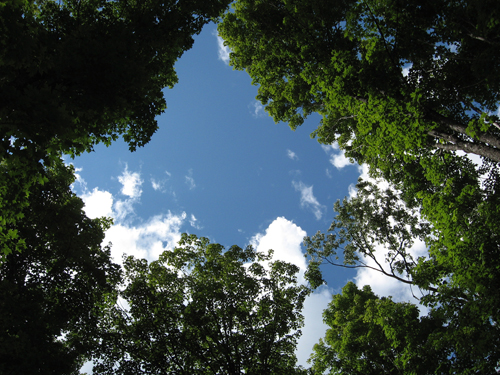EAST LANSING, Mich. — In a sweeping study of a huge swath of Michigan’s Upper Peninsula, Michigan State University researchers document that in many places the sugar maple saplings that should be thriving following harvesting are instead ending up as a deer buffet. This means the hardwood forests are not regenerating.
Since the 1950s, sustainability in northern hardwood forests was achieved by chopping down trees in small clumps to naturally make room for new ones to spring up. Early experiments with single-tree and group selection logging found that desirable species like sugar maples did a great job of regenerating in the sunny, rain-drenched harvest gaps – theoretically eliminating the need to replant.
But hungry deer and other factors have changed that, according to a study in Forest Ecology and Management.
“We’ve found that deer, light availability and competition from nontree plant species are affecting sugar maple regeneration in parts of the Upper Peninsula,” said Megan Matonis, who recently earned a master’s degree in forestry while a member of the Center for Systems Integration and Sustainability at MSU. “No sugar maples are regenerating in the southern area near Escanaba. In the future, this could challenge the sustainability of timber harvesting in this region.”
Forest conservation is a persistent push and pull between maintaining crops of hardwoods, especially sugar maple, for the timber industry and herds of deer for hunters.

MSU researchers are examining why sugar maples are not thriving like they once did. Photo credit: Courtesy of MSU.
“It’s amazing how differently these two groups generally view the situation,” said Matonis, who published the paper with Michael Walters, MSU associate professor of forestry, and James Millington, postdoctoral researcher. “Some hunters feel there aren’t enough deer in the forests whereas ‘save a tree, kill a deer’ is the sentiment of many loggers.”
The study lasted two years and spanned 3,000 square miles of public and private land. Researchers examined the harvest gaps left in forests when hardwoods are cut down with the goal of determining what factors affect the regeneration of sugar maples.
What they found is that in the north, where heavy snows push deer south in search of food during the winter, sugar maple saplings generally are thriving in the harvested areas. Yet in the southern portion of the study area, there were areas where no saplings survive.
Matonis said that although munching by deer seems to be the main cause of low sapling densities in the south, other factors also make it a tough life for saplings. Low light levels in small gaps and competition from other plants also play roles in poor regeneration. Sedge, a grass-like plant, appears to out-compete tree saplings in many forests following harvests.
The research is funded by the U.S. Department of Agriculture and the Michigan Department of Natural Resources. Currently, Matonis is a doctoral student at Colorado State University and Millington is now a Leverhulme Early Career Fellow at King’s College in London.
*Source: Michigan State University
